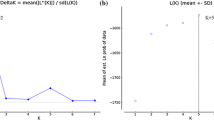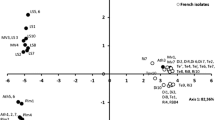Abstract
Amplified fragment length polymorphism (AFLP) was used to study the genetic structure of populations of the willow leaf rust, Melampsora epitea, in Swedish willow plantations. In total, 197 isolates collected from Salix viminalis clones in three locations in Sweden were analysed. AFLP profiles based on 83 markers were used to compute genetic distances between pairs of individuals. High levels of gene and genotypic diversity were detected in all populations, with 96% of the AFLP loci being polymorphic and with normalized Shannon's diversity indices ranging from 0.977 to 1.0. Analysis of molecular variance (AMOVA) showed small significant differences among locations, although most of the molecular variability was found within locations (97.5%). Five isolates from one willow clone in one location differed markedly from the common pattern. When these five exceptional isolates were excluded, no significant differences among willow clones were found with AMOVA. Sexual reproduction and spore migration appear to be important factors for the population genetic structure of this pathogen.
Similar content being viewed by others
REFERENCES
Aagaard JE, Krutovskii KV and Strauss SH (1998) RAPDs and allozymes exhibit similar levels of diversity and differentiation among populations and races of Douglas-fir. Heredity 81: 69–78
Apostol BL, Black IV WC, Reiter P and Miller BR (1996) Population genetics with RAPD-PCR markers: Aedes aegypti in Puerto Rico. Heredity 76: 325–334
Armstrong J, Gibbs A, Peakall R and Weiller G (1996) The Rapdistance Package, Version 1.04. Australian National University, Canberra
Aylor DE (1990) The role of intermittant wind in the dispersal of fungal pathogens. Annual Reviewof Phytopathology 28: 73–92
Burdon JJ and Roelfs AP (1985) The effect of sexual and asexual reproduction on the isozyme structure of Puccinia graminis. Phytopathology 75: 1068–1073
Charlesworth B (1998) Measures of divergence between populations and the effect of forces that reduce variability. Molecular Biology and Evolution 15: 538–543
Chen XM, Line RF and Leung H (1993) Relationship between virulence variation and DNA polymorphism in Puccinia striiformis. Phytopathology 83: 1489–1497
Dawson WM and McCracken AR (1994) Effect of Melampsora rust on the growth and development of Salix burjatica ‘Korso’ in Northern Ireland. European Journal of Forest Pathology 24: 32–39
Excoffier L, Smouse PE and Quattro JM (1992) Analysis of molecular variance inferred from metric distances amongDNA haplotypes: application to human mitocondrial DNA restriction sites. Genetics 131: 479–491
Felsenstein J (1993) PHYLIP (Phylogeny Inference Package) Version 3.5c. Distributed by the author. Department of Genetics, University of Washington, Seattle
Goodwin SB, Spielman L, Matuszak JM, Bergeron SN and Fry WE (1992) Clonal diversity and genetic differentiation of Phytophtora infestans populations in northern and central Mexico. Phytopathology 82: 955–961
Hamelin R, Doudrick RL and Nance WL(1994) Genetic diversity in Cronartium quercuum f.sp. fusiforme on loblolly pines in southern U.S. Current Genetics 26: 359–363
Hansen M, Kraft T, Christiansson M and Nilsson N-O (1999) Evaluation of AFLP in Beta. Theoretical and Applied Genetics 98: 845–852
Hartl DL and Clark AG (1989) Principles of population genetics, 2nd edn. Sinauer Associates, Sunderland, Massachusetts.
Larsson G and Bremer B (1991) Korgviden - nyttoväxter förr och nu. (The Salix viminalis group - useful plants then and now.) Svensk Botanisk Tidskrift 85: 185–200
Larsson S (1998) Genetic improvement of willow for short-rotation coppice. Biomass and Bioenergy 15: 23–26
Lynch M and Milligan BG (1994) Analysis of population genetic structure with RAPD markers. Molecular Ecology 3: 91–99
Nagarajan S and Singh DV (1990) Long-distance dispersion of rust pathogens. Annual Review of Phytopathology 28: 139–153
Nei M and Li WH (1979) Mathematical model for studying genetic variation in terms of restriction endonucleases. Proceedings of the National Academy of Sciences of the USA 76: 5269–5273
Page RDM (1996) TREEVIEW: An application to display phylogenetic trees on personal computers. Computer Applications in the Biosciences 12: 357–358
Parker SR, Royle DJ and Hunter T (1993) Impact of Melampsora rust on yield of biomass willows. In Abstracts of the 6th International Congress of Plant Pathology, Montreal, Canada, 28 July-6 August 1993, p. 117
Pei MH, Royle DJ and Hunter T (1993) Identity and host alternation of some willow rusts (Melampsora spp.) in England. Mycological Research 97: 845–851
Pei MH, Royle DJ and Hunter TA (1995) A comparative study of stem-and leaf-infecting forms of Melampsora rust on Salix viminalis in the U.K. Mycological Research 99: 357–363
Pei MH, Royle DJ and Hunter T (1996) Pathogenic specialization in Melampsora epitea var. epitea on Salix. Plant Pathology 45: 679–690
Pei MH, Whelan MJ, Halford NG and Royle DJ (1997) Distinction between stem-and leaf-infecting forms of Melampsora rust on Salix viminalis using RAPD markers. Mycological Research 101: 7–10
Pei MH, Royle DJ and Hunter T (1999) Hybridization in larchalternating Melampsora epitea (M. larici-epitea). Mycological Research 103: 1440–1446
Pei MH and Ruiz C (2000) AFLP evidence of the distinctive patterns of life-cycle in two forms of Melampsora rust on Salix viminalis. Mycological Research 104: 937–942
Pinon J, van Dam C, Genetet I and de Kam M (1987) Two pathogenic races of Melampsora larici-populina in northwestern Europe. European Journal of Forest Pathology 17: 47–53
Ramstedt M (1999) Rust disease on willows - virulence variation and resistance breeding strategies. Forest Ecology and Management 121: 101–111
Roelfs AP (1986) Development and impact of regional cereal rust epidemics. In: Leonard KJ, Fry WE (eds) Plant Disease Epidemiology: Population Dynamics and Management (pp 129-150), Macmillan, New York
Ross KG, Shoemaker DD, Krieger MJB, DeHeer CJ and Keller L (1999) Assessing genetic structure with multiple classes of molecular markers: a case study involving the introduced fire ant Solenopsis invicta. Molecular Biology and Evolution 16: 525–543
Saitou N and Nei M (1987) The neighbor-joining method: a new method for reconstructing phylogenetic trees. Molecular Biology and Evolution 4: 406–425
Shan W, Chen S, Kang Z, Wu L and Li Z (1998) Genetic diversity in Puccinia striiformis Westend. f.sp. tritici revealed by pathogen genome-specific repetitive sequence. Canadian Journal of Botany 76: 587–595
Sheldon AL (1969) Equitability indices: dependance on the species count. Ecology 50: 466–467
Schneider S, Kueffer JM, Roessli D and Excoffier L (1997) Arlequin Version 1.1: a software for population genetic data analysis. Genetic and Biometry Laboratory, University of Geneva, Switzerland
Spiers AG and Hopcroft DH (1996) Morphological and host range studies of Melampsora rusts attacking Salix species in New Zealand. Mycological Research 100: 1163–1175
Van Arsdel EP (1967) The nocturnal diffusion and transport of spores. Phytopathology 57: 1221–1229
Vos P, Hogers MB, Reijans M, van de Lee T, Hornes M, Frijters A, Pot J, Peleman J, Kuiper M and Zabeau M (1995) AFLP: a new technique for DNA fingerprinting. Nucleic Acids Research 23: 4407–4414
Verwijst T (1989) Clonal differences in the structure of a mixed stand of Salix viminalis in response to Melampsora and frost. Canadian Journal of Forest Research 20: 602–605
Wilson M and Henderson DM (1966) The British Rust Fungi. Cambridge University Press, Cambridge, UK
Author information
Authors and Affiliations
Rights and permissions
About this article
Cite this article
Samils, B., Lagercrantz, U., Lascoux, M. et al. Genetic Structure of Melampsora Epitea Populations in Swedish Salix Viminalis Plantations. European Journal of Plant Pathology 107, 399–409 (2001). https://doi.org/10.1023/A:1011270315251
Issue Date:
DOI: https://doi.org/10.1023/A:1011270315251




